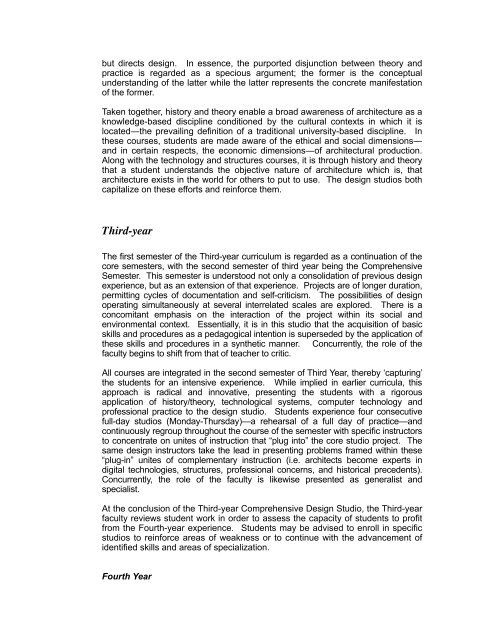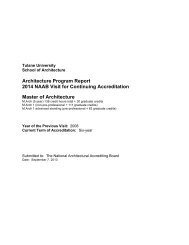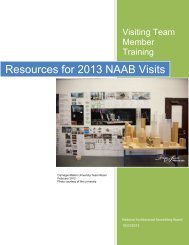Architecture Program Report Tulane University New Orleans ...
Architecture Program Report Tulane University New Orleans ...
Architecture Program Report Tulane University New Orleans ...
You also want an ePaper? Increase the reach of your titles
YUMPU automatically turns print PDFs into web optimized ePapers that Google loves.
ut directs design. In essence, the purported disjunction between theory and<br />
practice is regarded as a specious argument; the former is the conceptual<br />
understanding of the latter while the latter represents the concrete manifestation<br />
of the former.<br />
Taken together, history and theory enable a broad awareness of architecture as a<br />
knowledge-based discipline conditioned by the cultural contexts in which it is<br />
located―the prevailing definition of a traditional university-based discipline. In<br />
these courses, students are made aware of the ethical and social dimensions―<br />
and in certain respects, the economic dimensions―of architectural production.<br />
Along with the technology and structures courses, it is through history and theory<br />
that a student understands the objective nature of architecture which is, that<br />
architecture exists in the world for others to put to use. The design studios both<br />
capitalize on these efforts and reinforce them.<br />
Third-year<br />
The first semester of the Third-year curriculum is regarded as a continuation of the<br />
core semesters, with the second semester of third year being the Comprehensive<br />
Semester. This semester is understood not only a consolidation of previous design<br />
experience, but as an extension of that experience. Projects are of longer duration,<br />
permitting cycles of documentation and self-criticism. The possibilities of design<br />
operating simultaneously at several interrelated scales are explored. There is a<br />
concomitant emphasis on the interaction of the project within its social and<br />
environmental context. Essentially, it is in this studio that the acquisition of basic<br />
skills and procedures as a pedagogical intention is superseded by the application of<br />
these skills and procedures in a synthetic manner. Concurrently, the role of the<br />
faculty begins to shift from that of teacher to critic.<br />
All courses are integrated in the second semester of Third Year, thereby ‘capturing’<br />
the students for an intensive experience. While implied in earlier curricula, this<br />
approach is radical and innovative, presenting the students with a rigorous<br />
application of history/theory, technological systems, computer technology and<br />
professional practice to the design studio. Students experience four consecutive<br />
full-day studios (Monday-Thursday)—a rehearsal of a full day of practice—and<br />
continuously regroup throughout the course of the semester with specific instructors<br />
to concentrate on unites of instruction that “plug into” the core studio project. The<br />
same design instructors take the lead in presenting problems framed within these<br />
“plug-in” unites of complementary instruction (i.e. architects become experts in<br />
digital technologies, structures, professional concerns, and historical precedents).<br />
Concurrently, the role of the faculty is likewise presented as generalist and<br />
specialist.<br />
At the conclusion of the Third-year Comprehensive Design Studio, the Third-year<br />
faculty reviews student work in order to assess the capacity of students to profit<br />
from the Fourth-year experience. Students may be advised to enroll in specific<br />
studios to reinforce areas of weakness or to continue with the advancement of<br />
identified skills and areas of specialization.<br />
Fourth Year














